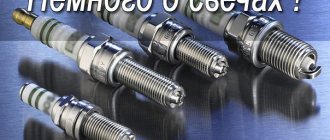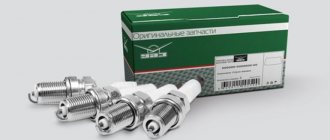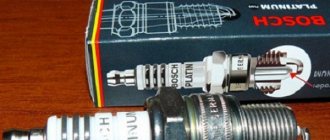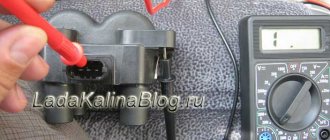How does a spark plug work, what is it intended for, and how can you determine which spark plugs on the market are suitable for your car?
That's what this article is about. Spark plugs are designed to ignite the fuel mixture in the cylinders of an internal combustion engine (ICE). Their greatest variety on the component market confuses even experienced motorists. And some “general mechanics” sometimes get confused and turn to motor mechanics, electricians and power system specialists with questions.
Candles should be selected according to a number of parameters, depending on:
— on the type of ignition (contact or contactless, battery, electronic, etc.);
— on the type of power system (carburetor, injector, mono- or multi-point injection, and so on), ;
— on the degree of engine boost (compression ratio, and, accordingly, compression);
— on the operating conditions of the engine and the types of fuel used (deformed, boosted, supercharged, turbocharged, sports, etc.).
What is the heat number of spark plugs
Surely, when working with spark plugs, you had a question, what do the numbers in the article mean?
For example: Denso IK20TT, Bosch WR M 7 DPX, NGK BKR6E-11.
These numbers, shown using three well-known brands, indicate the heat rating.
This value indicates in what thermal range the spark plug should operate.
Don't know which candle to choose? Call and we will help! Phone: 8 (495) 374-74-96
Thermal range is the ability to transfer heat from the plug to the cylinder head to maintain optimal temperature. In contact with combustion products during operation, the spark plug heats up. The optimal temperature range is from 400 to 900 degrees.
Failure to comply with the thermal range due to incorrect selection of spark plugs can lead to the following consequences:
- the spark plug operates at temperatures below 400 degrees – accumulation of carbon deposits and engine shutdown;
- the spark plug operates at temperatures above 900 degrees at high speeds – glow ignition and engine damage.
Let's decipher the so-called cold and hot candles:
- “hot” – the candle removes less heat. The lower the heat value, the “hotter” the candle;
- “cold” - the candle is able to remove more heat. The higher the heat value, the “colder” the candle.
Heat rating from different manufacturers
Unfortunately, the main manufacturers do not have a unified system for designating heat numbers. There is a mapping table.
Brand
Cold
hot
| GOST RosStandard | 23 | 20 | 17 | 14 | 11 | |||
| Denso | 22 | 20 | 16 | x | ||||
| Bosch | 5 | 6 | 7 | 8 | 9 | 10 | ||
| NGK | 7 | 6 | 5 | x | ||||
| Beru | 5 | 6 | 7 | 8 | 9 | 10 | ||
| Champion | x | 7 | 8 | 9 | 10 | 11 | 12 | x |
| MotorCraft | x | 22 | 32 | 42 | 82 | x | ||
| Prestolite | x | 22 | 32 | 42 | 82 | x | ||
| AutoLite | 3 | 4 | 5 | x | ||||
| BRISK | x | 14 | 15 | 17 | 19 | |||
| ISKRA | 95 | 85 | 65 | 55 | x |
Detailed diagram of Denso heat numbers
Plugs with a heat rating of 9–14 are used in industrial engines. In this case, "hot" spark plugs are required: the engine is often running at a constant speed just above idle, there is a risk that the plug will not reach 450 degrees and the thermal range required for self-cleaning. Therefore, the temperature needs to be increased.
The heat number of spark plugs for ordinary cars is 16, 20, 22.
“Cold” spark plugs with a heat rating of 24–31 are used in sports cars whose engines operate at high speed for a long time.
The Auto-Svecha store recommends that you follow the recommendations of our catalogs and select spark plugs with the optimal heat rating.
avto-svecha.ru
All about the most important parameter when choosing a spark plug - heat rating
The heat number of spark plugs is of great importance for the car and its owner, a summary table of which is given in our article. You will learn everything about what this parameter means and how to choose candles using it in our article.
CN is a certain value. It is proportional to the average pressure at which the housing temperature can lead to glow ignition. This, in turn, is the uncontrolled ignition of the working mixture due to the heated parts of the spark plug.
In Russia, industry produces parts with values of 8, 11, 14, 17, 20, 23, 26. In other countries, a unified scale has not been developed.
Abroad, all models are conditionally divided into several groups:
- hot (from 11 to 14);
- average (from 14 to 17);
- cold (20 or more);
- unified (their number ranges from 11 to 20).
Causes of glow ignition
Consequences of short circuit
It should be understood that under this term in the automotive industry there are two different phenomena. The first of these is the method of igniting fuel, which was widely used before the introduction of the spark system. Today this method is much less common, although it is still found on diesel engines. The fuel was ignited by a very hot head, which had to be preheated.
In the modern situation, the term most often refers to a negative effect in which fuel ignition occurs due to overheating of individual parts. Its reasons may be different.
Most often this occurs due to overheating of the spark plug insulation. It is likely that a model was used that did not have a high enough number, meaning that it accumulated too much heat. Carbon particles may also be the cause.
This phenomenon can cause the engine to continue to run even after the spark is turned off. To stop it, you will need to stop the fuel supply. Modern carburetors have solenoid valves that block the flow of fuel when the ignition is turned off (video author - NGKSparkPlugEurope).
Using a table to avoid glow ignition
The model table below is based on models from different manufacturers. They are related to each other according to their heat rating.
Thanks to this table, you can select a new part to replace the old one. At the same time, you can be sure that it meets the requirements of your engine if the old one met them. It is recommended to choose factory spark plugs or their analogues, since with them the likelihood of the negative effect described above is least likely. So, for example, the Russian A11 can be replaced by the Japanese B4H.
Model table
What does the CC depend on?
To test Russian parts, a test setup consisting of one supercharged cylinder is used. The pressure increases until the fuel from the housing ignites. Thus, the average indicator pressure of the cycle is calculated. This is what becomes the meaning for this detail.
There is a certain relationship with such parameters as liter engine power, compression ratio, rotation speed. The higher they are, the higher the CN a candle is required. An increased value, for example, will be required for air-cooled and two-stroke engines.
1. Spark plugs for the most popular Russian cars 2. Internal design
Determination of spark plug CN
The test that is carried out to determine the CN of candles in Russia is indicated above. Abroad, the time was previously indicated after which during testing the fuel ignited due to glow ignition. This value is 10 or more times higher than the number on Russian models. Because of these differences, when replacing parts, it is better to rely on the values indicated in the table above.
Video “Choosing candles”
This video talks about how to choose candles, including taking into account the CC (the author of the video is Avtosferaomsk).
AvtoZam.com
Stages of replacing spark plugs on a VAZ 2101
On classic Lada cars or the more familiar Zhiguli, a convenient replacement of spark plugs is provided. They are located in good accessibility on the left side of the engine in the direction of travel; they can be reached from the engine compartment.
During the production of the VAZ 2101, a large number of modifications were produced, which were equipped with various engines. Experienced drivers note good maintainability, unpretentiousness in maintenance, as well as consumables.
There are no global differences in versions with different engine sizes when replacing, all actions will be almost the same.
Before you begin replacing the ignition elements, you must take precautions. And in order to make it easier to screw in and subsequently unscrew the spark plug, you can apply a little graphite from a soft pencil to the threads or a little copper grease. But oil or regular grease will cause the spark plug to stick to the threads of the cylinder head.
Removing old ones
The procedure for replacing spark plugs on a VAZ 2101 is very simple and even a beginner who has never looked under the hood of his car can handle it. To carry out this repair, we will need a spark plug wrench or a special socket with a wrench.
Let's move on to replacement:
- First of all, open the hood of your car and remove the high-voltage wires from each spark plug.
- After this, take a 21 key or socket and unscrew the spark plugs one by one.
- We pay attention to the appearance of the electrodes, the formation of soot and all kinds of deposits, as well as the gap between the electrodes.
In order for the engine to run perfectly with new spark plugs, it is necessary to correctly set the gap between the electrodes. How to do this is described below.
When installing new spark plugs, it is recommended not to be overzealous with the tightening force, otherwise you can strip the threads on the block, which will lead to expensive repairs.
Ideally, if you have a torque wrench, in this case the recommended tightening torque is 20-30 Nm.
Checking the gap
Most car owners do not even know that the size of the gap between the side and central electrodes of the spark plugs affects many engine parameters.
- Firstly, if the spark plug gap is set incorrectly, then the VAZ 2101 will not start as well as with optimal parameters.
- Secondly, the dynamic characteristics will become much worse, since the mixture will not ignite correctly and will not all burn out.
- And the consequence of the second point is an increase in fuel consumption, which will affect not only engine parameters but also the wallet of VAZ 2101 owners.
What should be the gap on VAZ 2101 spark plugs?
Due to the fact that “classic” models use both contact and non-contact ignition systems, the gap is set in accordance with the installed spark generation system.
- If you have a distributor with contacts installed, then the gap between the electrodes should be within 0.5-0.6 mm.
- In the case of installed electronic ignition, the spark plug gap will be 0.7-0.8 mm.
How to correctly set the gap between spark plug electrodes on a VAZ 2101
In order to adjust the gap, we need a set of feeler gauges with plates of the required thickness. The gap is measured with a flat feeler gauge; in spark plugs with several side electrodes - with a round one.
Then we select the required thickness of the probe for your ignition system and insert it between the side and central electrodes of the spark plug. The probe should fit tightly, but not with great force.
We carry out a similar operation with the remaining candles. We screw everything into place and are satisfied with the excellent operation of the engine.
Heat number in the spark plug device - table
Hi all! If you own a car with a gasoline engine, sooner or later, dear friends, you will have to deal with purchasing a spark plug. And here the salesperson at a car dealership can take you by surprise with just one question: “What heat rating are you interested in?” After such a turn, an inexperienced driver can quickly leave the establishment without purchasing anything. What about beginners, even if for some experienced ones such a meaning is like the multiplication table for first-graders. But it is precisely this figure that is the main parameter of any candle and ignoring it when buying is more expensive for yourself! The table of spark plug heat ratings, which you will find below, will definitely help when choosing, but I still recommend reading it carefully, it is important to grasp the essence and understand what it is!
Content
What is glow ignition?
By and large, the heat rating is nothing more than a certain temperature limit for a specific spark plug. You've probably heard, and maybe even seen, the first internal combustion engines; they were called semi-diesels. The ignition system on already antediluvian engines looked a little different; there was no spark at all. The fuel ignition occurred from the hot cylinder head. The glow plug was responsible for heating it, which automatically turned off after starting the engine, and then the engine functioned without it.
Today, every modern car is equipped with an intermittent ignition system, that is, the spark plug turns on when fuel enters the cylinder, ignites it and turns off accordingly. However, in order for everything to work so smoothly, the engineer had to rack his brains to create the candle in its current form. The thing is, even in this mode of operation, the part still continued to heat up. On the one hand, this is great, because when it reaches a certain temperature, it is capable of self-cleaning from carbon deposits. But on the other hand, such a trend could easily destroy the power unit with an effect that was called glow ignition.
Note: the selection of spark plugs for HBO is no different from gasoline modifications.
What does this mean? See, even if the spark is stopped, the heated plug behaves like "young years". That is, the ignition of the fuel will continue continuously! There are only two ways to stop this process:
- Shut off the fuel supply.
- Wait for it to cool completely.
Otherwise, the heated spark plug will continually try to shift the ignition timing, which will certainly lead to a strong jerk of the crankshaft in the opposite direction, and this in turn will lead to a rupture of the power unit. In order to avoid such consequences, experts have found the ideal heat value for spark plugs, at which they will heat up exclusively to the self-cleaning temperature. And as you yourself understand, under such circumstances the engine is in no danger. Tell me, friends, do you know many people whose engine was damaged because of such a trifle? I'm sure not! This means that the engineers’ theory turned out to be correct, so that’s good for us!
Types of spark plugs
Remember in the last article we talked about how to decipher the markings on a spark plug? If you missed that publication, be sure to find it and read it, so you will learn how to identify a part with the necessary characteristics. So, then I think I already said that there are no clear standards in the world regarding labeling, which significantly complicates the life of an inexperienced car owner. The same can be said about the heat number. All foreign or “Champion” models can be divided into four types:
- Cold - heat rating of 20 and above.
- Average - from 17 to 19.
- Hot – from 11 to 17.
- Unified - from 11 to 20.
In the domestic industry, on the contrary, there are certain standards! So, absolutely all manufacturers produce spark plugs exclusively with the following values: 8, 11, 14, 17, 20, 23 and 26. Numbers of a larger value are considered cold, and numbers of a small value are considered hot.
Compatibility table
The figure located above these lines will help us figure out which heat rating is suitable for a certain type of transport.
- Hot - used in everyday cars, that is, in those that most of us drive).
- Medium - used in engines not suitable for boosting.
- Cold - suitable exclusively for powerful engines, found mainly in sports cars.
However, this scheme does not solve the issue of compatibility of foreign candle models with domestic analogues. How to find out an existing alternative, for example, to the good old model “A10N”? Calm down, below I suggest you familiarize yourself with another table! She will definitely answer all your questions!
A little more about the heat number and the consequences of choosing it incorrectly
How do experts so accurately determine the heat rating of each specific candle, they don’t take it out of their heads. I’ll answer my own question! No, not from the head, everything is much simpler! Any Russian plant specializing in the production of such products has a special testing facility. In fact, this is an ordinary inflated cylinder! So, by artificially increasing the pressure in it, engineers record the moment of ignition of the fuel from the body. Based on these data, a number called the glow number is derived. The main thing to understand here is that the value of this value is influenced by such engine characteristics as:
- Crankshaft speed;
- Compression ratio;
- Power;
- Engine volume.
In conclusion, I would like to talk about the consequences of glow ignition. If you are confused, the spark plugs are flooding, why is it not clear? First of all, make sure that all the ignition wires are tightly connected to the spark plug and that there are no breaks. Check the spark plug itself; if it is not working properly, go to the “All about replacing spark plugs” section. But that’s the rub - a candle can be absolutely working, but it’s just chosen incorrectly.
It would seem that a small thing is true, but the consequences can be very serious. Increased consumption, cylinder misfire, weak spark - all these are serious signs of trouble with your car, and the source of the problem is a small spark plug. Don't underestimate her, too lazy to delve into all this? No problem, the Internet will help! Find out how to choose spark plugs based on your car make here. Well, it’s time for me to leave, all the best!
Best regards, Maxim Markov!
carsmotion.ru
Compatibility table
The figure located above these lines will help us figure out which heat rating is suitable for a certain type of transport.
- Hot - used in everyday cars, that is, in those that most of us drive).
- Medium - used in engines not suitable for boosting.
- Cold - suitable exclusively for powerful engines, found mainly in sports cars.
However, this scheme does not solve the issue of compatibility of foreign candle models with domestic analogues. How to find out an existing alternative, for example, to the good old model “A10N”? Calm down, below I suggest you familiarize yourself with another table! She will definitely answer all your questions!
Marking and heat rating of spark plugs
Automotive spark plugs are designed to ignite the fuel-air mixture in the combustion chamber of an internal combustion engine by producing a spark. The stability and uninterrupted operation of the engine of any car running on gasoline or natural gas depends on their performance.
The design of automotive spark plugs is quite simple. The spark plug body contains a metal rod - the central electrode, which, in turn, is fixed by a ceramic insulator and is equipped with a contact terminal for connecting the high-voltage wire of the ignition system. Since the central electrode is the hottest part in the spark plug design, its insulator must withstand electrical voltages of up to 60 kV and temperatures of up to 1000 °C.
To protect the spark plug from the penetration of hot gases emanating from the engine combustion chamber, special gaskets are installed between its housing and the insulator. The housing itself has a thread with which the spark plug is screwed into the cylinder head. In addition, the spark plug body is also a conductor between the vehicle ground and the side electrode (or electrodes) welded to the body in close proximity to the central electrode, and also serves to remove heat from the spark plug elements.
Spark plug heat number
And so, let's take a closer look at what the heat number of spark plugs is and what it means. So, the heat number is a conditional thermal equivalent that indicates the maximum permissible temperature load of the spark plug, above which an uncontrolled process of chaotic ignition of the working mixture (glow ignition) appears in the cylinder of an internal combustion engine.
The maximum temperature of the spark plug at which the glow ignition effect occurs, as a rule, does not exceed 900 °C. But due to the huge number of design solutions from different internal combustion engine manufacturers, the temperature in the combustion chambers of engines from different manufacturers also changes differently. Therefore, glow ignition in such engines also occurs at different temperatures.
The markings on modern spark plugs indicating the heat rating of domestic manufacturers differ from their foreign counterparts. So in Russia the following series of heat numbers is considered generally accepted:
- 11-14 - hot candles;
- 17-19 - medium candles;
- 20 or more - cold candles.
There are also standardized spark plugs with a heat rating from 11 to 20, but they are less common.
Table with markings of the heat ratings of spark plugs from Russian manufacturers and their interchangeability with imported analogues:
| Russia | Beru | Bosch | Brisk | Champion | NGK | Nippon Denso |
| A11, A11-1, A11-3 | 14-9A | W9A | N19 | L86 | B4H | W14F |
| A11P | 14R-9A | WR9A | NR19 | RL86 | BR4H | W14FR |
| A14B, A14B-2 | 14-8B | W8B | N17Y | L92Y | BP5H | W16FP |
| A14VM | 14-8BU | W8BC | N17YC | L92YC | BP5HS | W16FP-U |
| A14VR | 14R-7B | WR8B | NR17Y | — | BPR5H | W14FPR |
| A14D | 14-8C | W8C | L17 | N5 | B5EB | W17E |
| A14DV | 14-8D | W8D | L17Y | N11Y | BP5E | W16EX |
| A14DVR | 14R-8D | WR8D | LR17Y | NR11Y | BPR5E | W16EXR |
| A14DVRM | 14R-8DU | WR8DC | LR17YC | RN11YC | BPR5E | W16EXR-U |
| A17B | 14-7B | W7B | N15Y | L87Y | BPR5ES | W20FP |
| A17D | 14-7C | W7C | L15 | N4 | BP6H | W20EA |
| A17DV, A17DV-1, A17DV-10 | 14-7D | W7D | L15Y | N9Y | B6EM | W20EP |
| A17DVM | 14-7DU | W7DC | L15YC | N9YC | BP6E | W20EP-U |
| A17DVR | 14R-7D | WR7D | LR15Y | RN9Y | BP6ES | W20EXR |
| A17DVRM | 14R-7DU | WR7DC | LR15YC | TRN9YC | BPR6ES | W20EPR-U |
| AU17DVRM | 14FR-7DU | FR7DCU | DR15YC | RC9YC | BCPR6ES | Q20PR-U |
| A20D, A20D-1 | 14-6C | W6C | L14 | N3 | B7E | W22ES |
| A23-2 | 14-5A | W5A | N12 | L82 | B8H | W24FS |
| A23B | 14-5B | W5B | N12Y | L82Y | BP8H | W24FP |
| A23DM | 14-5CU | W5CC | L82C | N3C | B8ES | W24ES-U |
| A23DVM | 14-5DU | W5DC | L12YC | N6YC | BP8ES | W24EP-U |
It should be remembered that for each engine it is necessary to use spark plugs only of the type recommended by the vehicle manufacturer. Other types of spark plugs interfere with engine operation by forming carbon deposits, oiling, or overheating the spark plug insulator. The average service life of spark plugs is usually about 20 thousand km.
Faulty spark plugs are highly likely to damage many expensive components of a car's ignition system. Therefore, if you suspect a malfunction of at least one of them, it is necessary to remove all spark plugs from the engine, clean them of carbon deposits, check and adjust the gap between the electrodes, wash them with gasoline, and then dry them well. Of course, if the spark plugs turn out to be beyond repair, they should be replaced with new ones. We also recommend an article that answers the question “Why is there no spark?” and how to troubleshoot a car's ignition system.
| spark plug heat rating |
unit-car.com
Checking and replacing the ignition coil
On rear-wheel drive cars of the classic family with a carburetor engine, the ignition coil (in automotive circles it is often called a “bobbin”) is installed in the engine compartment on the left mudguard and secured with two nuts.
On later injection versions, an ignition module is installed, mounted on the cylinder block.
Before deciding to replace the coil, you should make sure that it is not working, otherwise the repair may be useless and money will be wasted.
Verification methods
The simplest method, which does not require special equipment, but is unsafe. Remove the central high-voltage wire and crank the engine by turning the ignition key. At the same time, we lean the removed wire against ground or the car body. If there is a spark, then the coil is ok. An assistant may be needed for this operation.
The second method, which is also more accurate, is to measure the resistance of the coil windings using a multimeter measuring device or “popularly” using a tester.
Measuring ignition coil resistance
We clean the coil contacts (studs on the body). The first check is the resistance of the primary winding. To do this, connect an ohmmeter to two studs and take measurements. Depending on the type of coil being tested, the resistance should be within the following limits: coil 2101-2107 B-117A = 3-3.5 Ohm; coil 2108-099 027.3705 = 0.45-0.5 Ohm.
Then we check the resistance in the secondary winding circuit. We connect one terminal of the tester to the central terminal of the high-voltage wire, and leave the second terminal of the probe at the terminal of the primary winding. In this case, the resistance of the working coil should be as follows: B-117A = 7.4-9.2 kOhm; 027.3705 = about 5 kOhm.
Replacement with a new one
To replace the ignition coil (bobbin) of a VAZ 2101, you must do the following:
- We remove the high-voltage wire from the coil cover.
- Using a size 8 wrench, unscrew the nut from the terminal marked “B” on the coil cover and remove the ends of the green and brown wires. To avoid losing small nuts, we recommend putting them in place.
- Similarly, disconnect the blue wire with a black stripe from the terminal marked with the letter “K”.
- If the colors of the wires turn out to be different, and this is possible, mark their position before disconnecting. From terminal “B” the wire is laid in the wiring harness, from terminal “K” - one is connected to the terminal of the ignition distributor, the second goes into the harness.
- Using a 10mm wrench, unscrew the coil mounting nuts three to four turns.
- We remove it from the car.
We install the new coil in the reverse order, observing the written order of connecting the wires.
Models and manufacturers
There are several models of ignition coils on the shelves of car dealerships. For “classics” (2101-2107) - B-117A, and for VAZ cars of the eighth family (2108-21099) - 027.3705.
Basically, all reels are of domestic production, manufacturing companies: ATE-2, Citron, Stary Oskol. According to numerous reviews, coils from Stary Oskol are considered to be the highest quality.
Informprostor dot com
Rating: 5 / 5
One day, I decided to replace the spark plug on my scooter, not that the previous one didn’t suit me, since there is no limit to perfection, and the scooter in winter refused to start with half a turn (sometimes our people ride scooters in winter or just start it as a preventive measure), I decided conduct an experiment, the essence of which was to replace a Ukrainian-made spark plug with a replacement for a stock scooter spark plug from the land of the rising sun, Japan. At that time, I did not understand whether the installed spark plug in the scooter was suitable for this engine and what kind of spark plug could be installed (analogue) if the spark plug recommended by the manufacturer was not available on the market. The task arose to understand the markings of spark plugs. Now, I decided to share the information I learned with the readers of Informprostor.com. Below I will write a decoding of the possible markings of spark plugs and, using the example of an NGK spark plug with the marking bpr6hs, which is what the manufacturer of Hondadio 35 (Honda Dio 35) recommends, I will show an example of decoding the markings. I would also like to emphasize that the most important characteristic of a spark plug is its heat rating.
NGK spark plug marking table
The first one or two characters of the marking indicate the thread diameter and key size.
- A – 18 mm (hex key 25.4 mm)
- B – 14 mm (hex key 20.8 mm)
- C – 10 mm (hex key 16.0 mm)
- D – 12 mm (hex key 18.0 mm)
- E – 8 mm (hex key 13.0 mm)
- G – PF 1/2 (hex key 23.8 mm)
- J – 12 mm (hex key 18.0 mm)
- AB – 18 mm (hex key 20.8 mm)
- BC – 14 mm (hex key 16.0 mm)
- BK – 14 mm (hex key 16.0 mm)
- DC – 12 mm (hex key 16.0 mm)
The next two symbols indicate the features of the candle.
- K – protruding end for 3/8″ wrench
- L – compact type (Shorty)
- M – compact type (Bantam)
- P – protruding insulator
- R – resistor
- U – surface or semi-surface discharge
- Z – induction resistor
Next is a number indicating the heat rating. Can take a value from 2 to 12. The higher the number, the colder the candle.
The next symbol indicates the thread length.
- E – 19 mm
- H – 12.7 mm – standard for HondaDio
- EH – half thread: total length 19.0 mm and thread length 12.7 mm
- FS – with 10.9 mm conical seat
- L – 11.2 mm
- S – 9.5 mm
- Z – 21.0 mm
The following symbol indicates the shape and characteristics of the electrodes.
- A – with special design
- B – for CVCC engine
- C – low angle side electrode
- CM – compact type with oblique ground electrodes
- E – V-shaped corrugated electrode (14.0 mm only) 1.5 mm insulator
- ES - standard spark plug with a long threaded part of 2.5 mm with a central electrode location
- F – with conical seat
- G – central electrode made of thin nickel alloy
- GG – copper electrode with grounding
- GV – gold-palladium central electrode
- J – two extended side electrodes
- K – two side electrodes
- M – two side electrodes, insulator length 18.5 mm
- T – three side electrodes
- Q – four side electrodes
- R – special electrode with grounding
- S – standard central electrode made of copper 2.5 mm
- P – central electrode made of platinum
- U – semi-surface discharge
- V – central electrode made of gold-palladium
- VX – special side electrode, center. platinum electrode
- W – tungsten central electrode
- X – clearance for increased productivity
- Y – V-shaped central electrode
- -L – intermediate thermal rating
- -LM – compact type (insulator length 14.5 mm)
- -N – grounding electrode with special dimensions
- IX – central electrode made of iridium
- Z – central electrode thickness 2.9 mm
The spark plug marking may end with a number indicating the spark plug gap in tenths of a millimeter. For example, -11 indicates a gap of 1.1 mm.
Example: BPR6HS spark plug has the following features:
- B – 14 mm thread for a standard 21 mm wrench
- P – with protruding insulator
- R – with resistor
- 6 – with heat number 6
- H – with thread length 12.7 mm
- S – with standard central electrode
Heat number - previously the value indicated the time indicated in seconds, after which the spark plug was heated to a red-hot state, at which heat ignition began (when the fuel is ignited not by the spark of the spark plug, but by the hot parts of the spark plug that are in direct contact with the fuel or nearby) . Now the measurement value of the glow number is the average indicator pressure at which glow ignition begins. A candle with a high heat number (for example, 8) is called cold and heats up later than a so-called hot candle with a low heat number (for example, 5).
The operating temperature of the spark plug is usually 500-600 degrees Celsius; at temperatures above 800 degrees, glow ignition may already occur. With the correct heat rating, the spark plug should self-clean (burn out) due to the temperature of its working parts. The effect of self-burnout can be achieved, in my opinion, by adjusting the carburetor by enriching and leaning the mixture, but this is another topic.
It makes sense to choose a candle based on travel distance and time of year. For long distances, also in summer, we can recommend a cold candle - with a heat number of 8-9; for short distances, also in spring-autumn, a hot candle - with a heat number of 6-7 and in winter an even hotter one with a heat number of 5.
Read in PDF format
informprostor.com










